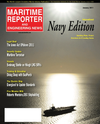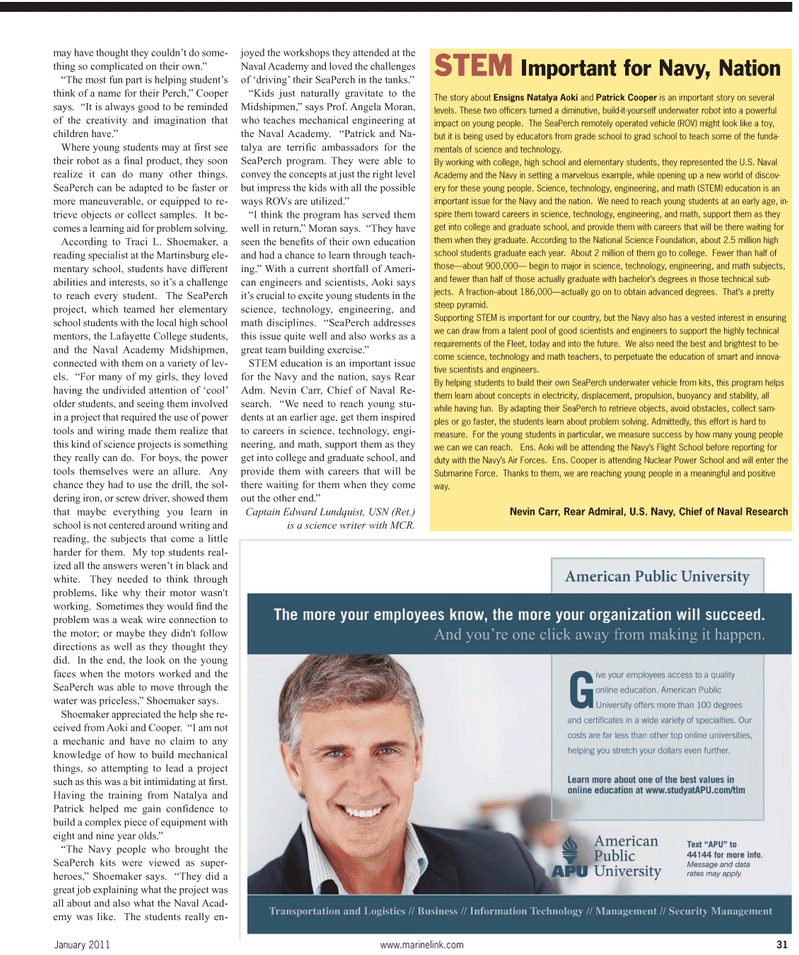
Page 31: of Maritime Reporter Magazine (January 2011)
International Naval Technology
Read this page in Pdf, Flash or Html5 edition of January 2011 Maritime Reporter Magazine
may have thought they couldn’t do some- thing so complicated on their own.” “The most fun part is helping student’s think of a name for their Perch,” Cooper says. “It is always good to be reminded of the creativity and imagination that children have.”
Where young students may at first see their robot as a final product, they soon realize it can do many other things.
SeaPerch can be adapted to be faster or more maneuverable, or equipped to re- trieve objects or collect samples. It be- comes a learning aid for problem solving.
According to Traci L. Shoemaker, a reading specialist at the Martinsburg ele- mentary school, students have different abilities and interests, so it’s a challenge to reach every student. The SeaPerch project, which teamed her elementary school students with the local high school mentors, the Lafayette College students, and the Naval Academy Midshipmen, connected with them on a variety of lev- els. “For many of my girls, they loved having the undivided attention of ‘cool’ older students, and seeing them involved in a project that required the use of power tools and wiring made them realize that this kind of science projects is something they really can do. For boys, the power tools themselves were an allure. Any chance they had to use the drill, the sol- dering iron, or screw driver, showed them that maybe everything you learn in school is not centered around writing and reading, the subjects that come a little harder for them. My top students real- ized all the answers weren’t in black and white. They needed to think through problems, like why their motor wasn't working. Sometimes they would find the problem was a weak wire connection to the motor; or maybe they didn't follow directions as well as they thought they did. In the end, the look on the young faces when the motors worked and the
SeaPerch was able to move through the water was priceless,” Shoemaker says.
Shoemaker appreciated the help she re- ceived from Aoki and Cooper. “I am not a mechanic and have no claim to any knowledge of how to build mechanical things, so attempting to lead a project such as this was a bit intimidating at first.
Having the training from Natalya and
Patrick helped me gain confidence to build a complex piece of equipment with eight and nine year olds.” “The Navy people who brought the
SeaPerch kits were viewed as super- heroes,” Shoemaker says. “They did a great job explaining what the project was all about and also what the Naval Acad- emy was like. The students really en- joyed the workshops they attended at the
Naval Academy and loved the challenges of ‘driving’ their SeaPerch in the tanks.” “Kids just naturally gravitate to the
Midshipmen,” says Prof. Angela Moran, who teaches mechanical engineering at the Naval Academy. “Patrick and Na- talya are terrific ambassadors for the
SeaPerch program. They were able to convey the concepts at just the right level but impress the kids with all the possible ways ROVs are utilized.” “I think the program has served them well in return,” Moran says. “They have seen the benefits of their own education and had a chance to learn through teach- ing.” With a current shortfall of Ameri- can engineers and scientists, Aoki says it’s crucial to excite young students in the science, technology, engineering, and math disciplines. “SeaPerch addresses this issue quite well and also works as a great team building exercise.”
STEM education is an important issue for the Navy and the nation, says Rear
Adm. Nevin Carr, Chief of Naval Re- search. “We need to reach young stu- dents at an earlier age, get them inspired to careers in science, technology, engi- neering, and math, support them as they get into college and graduate school, and provide them with careers that will be there waiting for them when they come out the other end.”
Captain Edward Lundquist, USN (Ret.) is a science writer with MCR.
January 2011 www.marinelink.com 31
STEM Important for Navy, Nation
The story about Ensigns Natalya Aoki and Patrick Cooper is an important story on several levels. These two officers turned a diminutive, build-it-yourself underwater robot into a powerful impact on young people. The SeaPerch remotely operated vehicle (ROV) might look like a toy, but it is being used by educators from grade school to grad school to teach some of the funda- mentals of science and technology.
By working with college, high school and elementary students, they represented the U.S. Naval
Academy and the Navy in setting a marvelous example, while opening up a new world of discov- ery for these young people. Science, technology, engineering, and math (STEM) education is an important issue for the Navy and the nation. We need to reach young students at an early age, in- spire them toward careers in science, technology, engineering, and math, support them as they get into college and graduate school, and provide them with careers that will be there waiting for them when they graduate. According to the National Science Foundation, about 2.5 million high school students graduate each year. About 2 million of them go to college. Fewer than half of those—about 900,000— begin to major in science, technology, engineering, and math subjects, and fewer than half of those actually graduate with bachelor’s degrees in those technical sub- jects. A fraction--about 186,000—actually go on to obtain advanced degrees. That’s a pretty steep pyramid.
Supporting STEM is important for our country, but the Navy also has a vested interest in ensuring we can draw from a talent pool of good scientists and engineers to support the highly technical requirements of the Fleet, today and into the future. We also need the best and brightest to be- come science, technology and math teachers, to perpetuate the education of smart and innova- tive scientists and engineers.
By helping students to build their own SeaPerch underwater vehicle from kits, this program helps them learn about concepts in electricity, displacement, propulsion, buoyancy and stability, all while having fun. By adapting their SeaPerch to retrieve objects, avoid obstacles, collect sam- ples or go faster, the students learn about problem solving. Admittedly, this effort is hard to measure. For the young students in particular, we measure success by how many young people we can we can reach. Ens. Aoki will be attending the Navy’s Flight School before reporting for duty with the Navy’s Air Forces. Ens. Cooper is attending Nuclear Power School and will enter the
Submarine Force. Thanks to them, we are reaching young people in a meaningful and positive way.
Nevin Carr, Rear Admiral, U.S. Navy, Chief of Naval Research

 30
30

 32
32
